Set along the Etowah River in Georgia, construction ended on Allatoona Dam, creating Lake Allatoona in 1949. Although it sadly flooded the town of Allatoona, along with homes, farms, and businesses, Lake Allatoona provides drinking water, flood control, recreation, and electricity to the surrounding areas.
Lake Allatoona offers activities like fishing, boating, camping, hiking, and bird watching and receives about six million visitors every year. The lake and its surrounding areas are also home to about 20 snake species. Fortunately, most are harmless, watersnakes and ratsnakes, but there are a couple of venomous snake species around Lake Allatoona.
Let’s take a look at some of the snakes you’ll find slithering around Lake Allatoona.

Allatoona Lake is the most popular lake in Georgia and is home to over 20 snake species.
©iStock.com/RobHainer
Dekay’s Brownsnake (Storeria dekayi)
One of the most common snakes slithering around Lake Altoona is also small, often smaller than 12 inches long. Dekay’s brownsnakes are semi-fossorial and spend much of their time underneath leaf litter, rotting logs, and other similarly moist areas.
These harmless snakes feast on slugs, snails, and earthworms, keeping the soft-bodied critters’ populations in check.

DeKay’s brownsnake preys mostly on soft-bodies animals such as slugs and earthworms.
©Paul Reeves Photography/Shutterstock.com
Common Watersnake (Nerodia sipedon)
This thick-bodied semiaquatic snake can spend hours in the waters of Lake Altoona. The common water snake also basks on rocks and hangs from tree branches, watching for fish to grab and eat.
Common watersnakes are nonvenomous but have razor-sharp teeth. They are harmless and mainly eat fish and frogs, but people often mistake them for venomous cottonmouths. However, Lake Allatoona is not home to the cottonmouth.
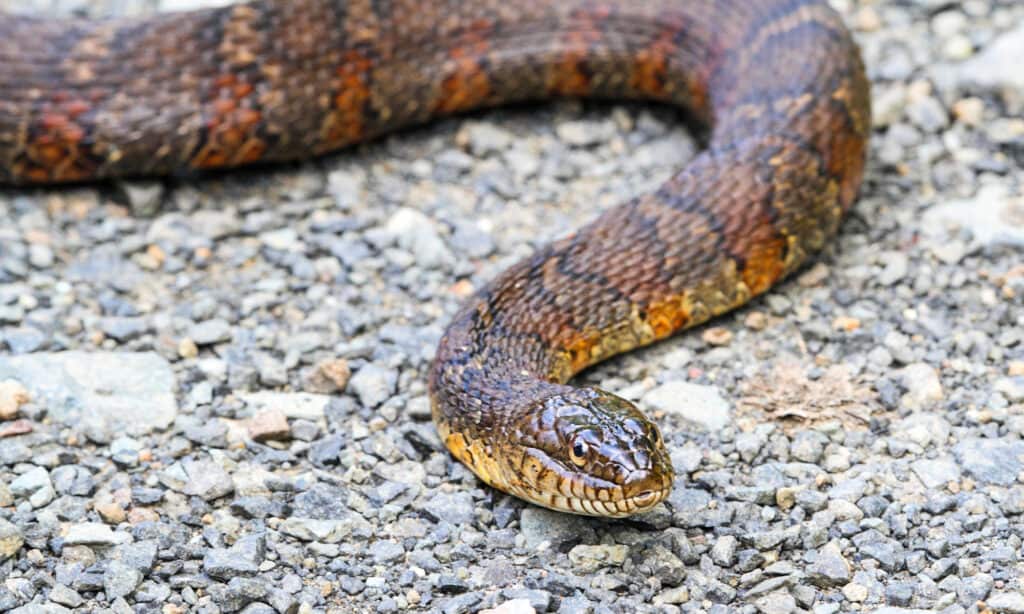
Northern watersnakes are one of the most widespread watersnakes in North America.
©Steve Byland/Shutterstock.com
Eastern Garter Snake (Thamnophis sirtalis sirtalis)
Also semiaquatic, eastern garter snakes are never far from water. So, Lake Allatoona provides a terrific habitat — its shores offer earthworms, amphibians, and other food, with plenty of wet places to hide.
Garter snakes can grow to about four feet long, but most are quite a bit smaller — around two or three feet. Although they’re harmless to humans, they have mildly venomous saliva and enlarged rear teeth. To get their saliva into prey, they have to puncture its skin and then sort of work the spit into the puncture wounds.
Fortunately, it only works on small prey like the amphibians they love to eat.

One of the most cold-tolerant snakes in the world, garter snakes are usually active early and later in the year than other species.
©Erik Agar/Shutterstock.com
Gray Ratsnake (Pantherophis spiloides)
Like its close cousins, the eastern and western ratsnakes, gray ratsnakes are rodent specialists that thrive in the trees. These snakes are fabulous climbers, and you are more likely to see one slithering through the trees around Lake Allatoona than on the ground.
Unlike their cousins, gray ratsnakes keep more of their patterns as they age and don’t get as dark. They can get up to six feet long or so and are completely harmless to people.

Gray ratsnakes retain most of their juvenile pattern as adults
©Jay Ondreicka/Shutterstock.com
Ring-Neck Snake (Diadophis punctatus)
Another small snail and slug eater, ring-neck snakes are common across much of North America. They’re in the top five snakes recorded around Lake Allatoona on iNaturalist and are also harmless.
Ring-necked snakes are often found underneath moist leaf litter, rocks, and rotten logs where their prey tends to hide. They’re named for the brightly-colored neck ring that often matches their belly color, which can be creamy white to bright red.
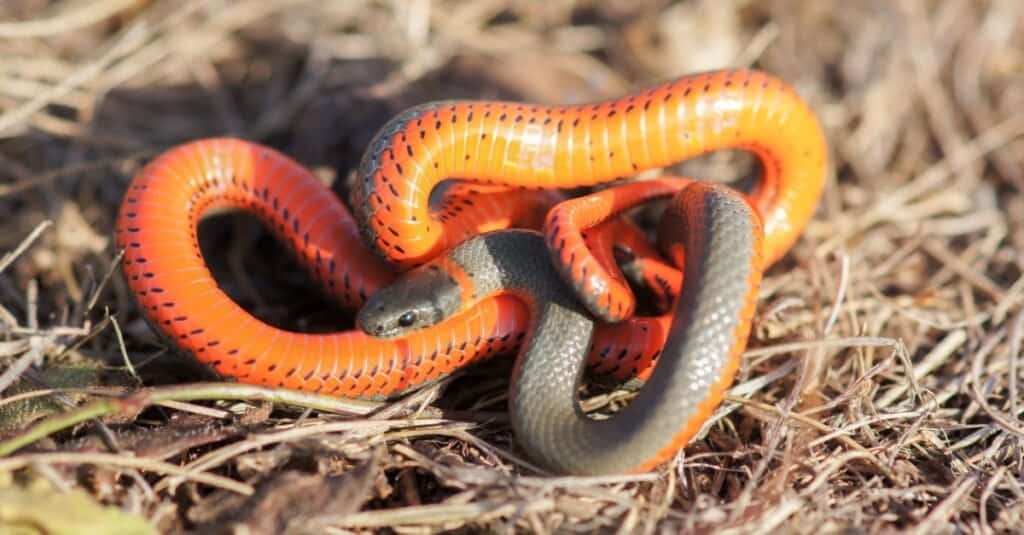
Small and colorful, the ring-necked snake is nocturnal and non-venomous.
©yhelfman/Shutterstock.com
Eastern Hognose Snake (Heterodon platirhinos)
If you ever come across one of these, you’re in for a treat. Eastern hognose snakes are known for dramatic defensive tactics. These snakes like to do their best imitation of something dead. A frightened hognose plays dead, excretes musk that it spreads on itself, and rolls over onto its back; leaving its mouth agape and tongue hanging out. If you watch closely, they are watching for when you leave, and the coast is clear.
Although mildly venomous, eastern hognose snakes are completely harmless to humans. Their venom is prey-specific and poses no threat to people unless you have an allergy.
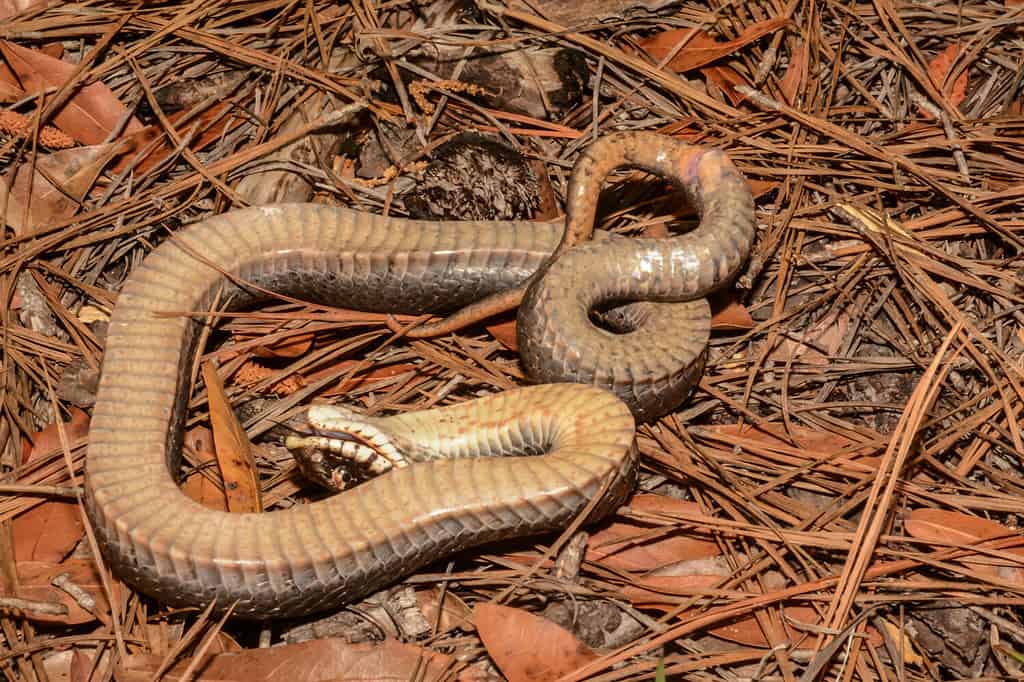
Their death-feigning eastern hognose’s antics are entertaining!
©Jay Ondreicka/Shutterstock.com
North American Racer (Coluber constrictor)
Sort of a catch-all name for all of the racers, there are several North American Racer subspecies. Location determines which racer is in your area and in this case, the black racer is most likely slithering around Lak Allatoona.
Far from being dangerous, racers are nonvenomous colubrids that have a fitting name. These snakes are fast and have excellent vision. Racers are likely to see you before you see them, leaving you wondering what was attached to the tail you saw slithering away.

Black racer snake crawling through Saint Augustine grass in Florida.
©iStock.com/sdbower
Eastern Kingsnake (Lampropeltis getula)
This big, beautiful, harmless snake eats anything it can grab, even venomous snakes. Eastern kingsnakes typically have white or yellow ring-like markings that cut between their black saddles.
These relatively docile snakes are a treat to observe and are generally easy to handle. Eastern kingsnakes can climb but are more often found near the ground. Around Lake Allatoona, eastern kingsnakes use the brush and rocks for cover while they rest at night, then they hunt during the day.
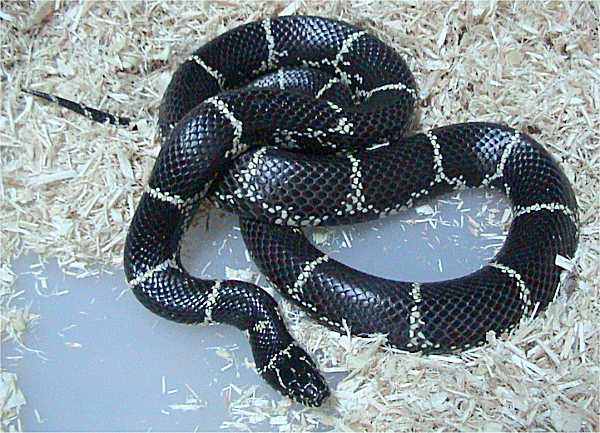
Eastern kingsnakes are big, muscular snakes that often eat venomous snakes too.
©en:User:Dawson, CC BY-SA 2.5 – License
Smooth Earthsnake (Virginia valeriae)
Only about nine inches long, smooth earthsnakes are very docile and not aggressive. Smooth earthsnakes eat earthworms and soft-bodied arthropods. So, to stay close to their food, smooth earthsnakes are fossorial, spending most of their time buried under leaf litter and loose soil.
If a smooth earthsnake gets really frightened, it may musk but even if it tries to bite, its mouth is so small that you may not feel it.

Although they’re often mistaken for other small snakes, smooth earth snakes are a species of their own.
©Matt Jeppson/Shutterstock.com
Plain-Bellied Watersnake (Nerodia erythrogaster)
Semiaquatic and feisty, plain-bellied watersnakes do not hesitate to bite repeatedly when someone picks them up. Although harmless, these snakes are known for razor-sharp teeth that they’re only too willing to use. Unfortunately for you, they also have a mild blood-thinner in their saliva so you’ll also bleed a bit.
Plain-bellied watersnakes are not as common as other watersnakes slithering around Lake Allatoona. However, these heavy-bodied snakes are often found sunbathing before they make a quick escape into the water.

Plain-bellied watersnakes are nonvenomous but have very sharp teeth.
©Tyler Albertson/Shutterstock.com
Venomous Snakes Slithering Around Lake Allatoona
If venomous snakes scare you more than anything else, Lake Allatoona isn’t a bad choice. The only two danger noodles whose ranges extend to the lake’s general vicinity are easily identifiable.
Eastern Copperhead (Agkistrodon contortrix)
This snake isn’t as big as the timber rattlesnake but causes about half of the venomous snakebites in the U.S. every year. Copperheads are so-named for their copper-colored heads. Eastern copperheads have hourglass-shaped chocolate brown to reddish saddle markings that look like chocolate kisses from the side.
Fortunately, their venom is not as dangerous as other pit vipers but a bite from a copperhead requires a trip to the emergency room.
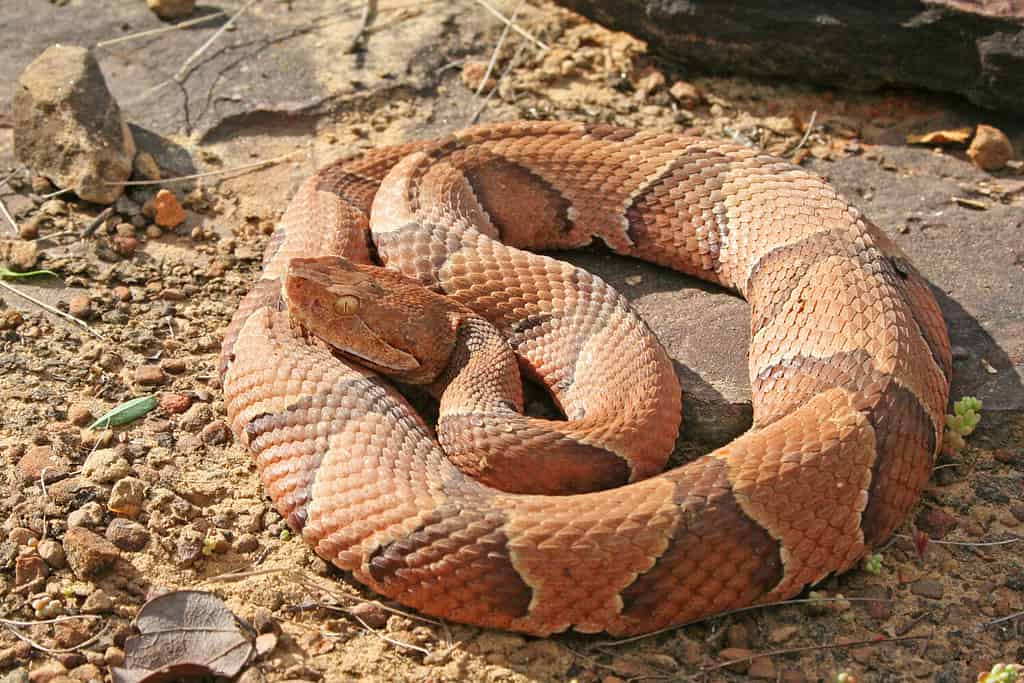
Copperhead venom isn’t as dangerous as others, but they are responsible for almost half of all snakebites in the U.S. annually.
©Creeping Things/Shutterstock.com
Timber Rattlesnake (Crotalus horridus)
Perhaps most famous for being on the bright-yellow Gadsden flag, timber rattlesnakes are also one of the biggest rattlers in the U.S. However, although these fearsome rattlesnakes can do some damage with a massive venom dose, they aren’t aggressive. In fact, they are so mild-mannered that you have to directly harass one to make them bite.
Timber rattlesnakes are more willing to take a swim than other rattlesnakes, especially if they get too hot. These snakes are fantastic swimmers and multiple videos show them cruising across water bodies to get wherever they’re going.
Depending on the locality, these snakes can either have neurotoxic venom, hemotoxic venom, a combination of both, or a fourth option which is probably the weakest venom – and common to Georgia.
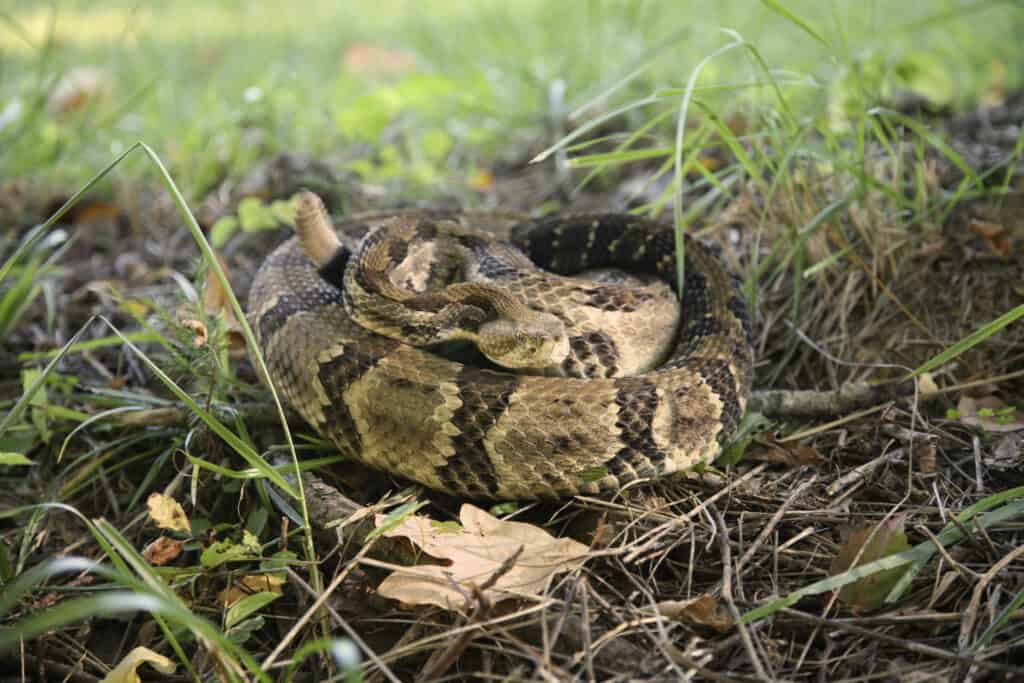
Timber Rattlesnakes are extremely venomous, but they are not aggressive.
©iStock.com/NajaShots
Snakebite First-Aid
Even though most of Lake Allatoona’s snakes are harmless, you should still use common sense if you’re bitten by one: washing the wound with soapy water and covering it with a bandage. Doing this should prevent any infection.
However, if a venomous snake bites you, the next steps taken can determine whether you have lasting damage from the venom. Here are a few basics:
Do:
- Call 911 and/or head to the nearest emergency room.
- Wash the bite with soap and water, then cover the bite wound.
- Remove constrictive clothing and jewelry.
- Stay calm!!
- Keep the extremity below the level of your heart, if possible.
Don’t:
- Apply a tourniquet.
- Absolutely do not cut open the wound and try to suck out the venom.
- Panic.
- Take any blood-thinning medications like aspirin or drink alcohol.
Other Animals Around Lake Allatoona
Far from being a snake-haven, Lake Allatoona has more than just snakes to offer! Here are a few other animals you might see around Georgia’s popular lake.
- Carolina Mantis (Stagmomantis carolina)
- Northern cardinal (Cardinalis cardinalis)
- Eastern chipmunk (Tamias striatus)
- Barred owl (Strix varia)
- Pickerel frog (Lithobates palustris)
- Bobcat (Lynx rufus)
Lake Allatoona Informational and Emergency Resources
When you spot a wild animal, the best thing to do is observe it from a respectful distance. Some animals are sensitive to interruptions, while others can become aggressive. If you need help moving dangerous animals from your campsite, calling local park staff is your best bet. There are several parks located around the lake, so be sure you know where you are before calling.
The photo featured at the top of this post is © iStock.com/RobHainer
Discover the "Monster" Snake 5X Bigger than an Anaconda
Every day A-Z Animals sends out some of the most incredible facts in the world from our free newsletter. Want to discover the 10 most beautiful snakes in the world, a "snake island" where you're never more than 3 feet from danger, or a "monster" snake 5X larger than an anaconda? Then sign up right now and you'll start receiving our daily newsletter absolutely free.
Thank you for reading! Have some feedback for us? Contact the AZ Animals editorial team.






